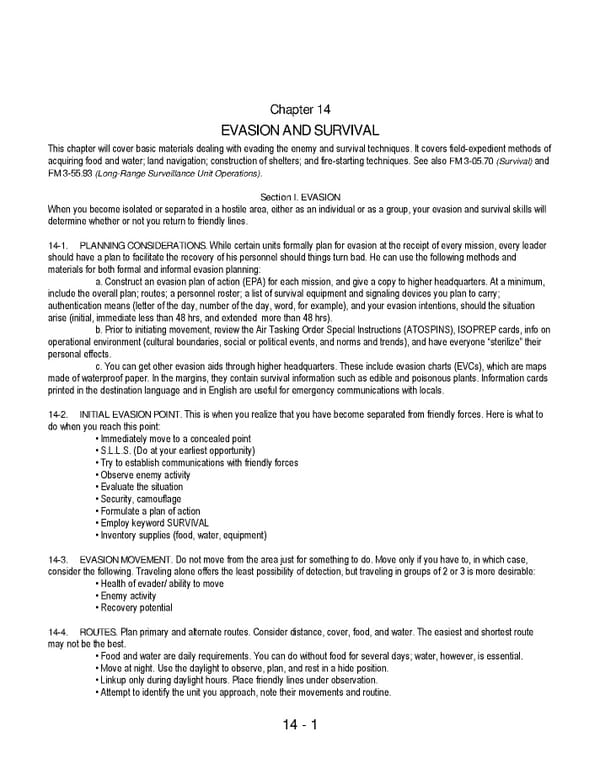14 - 1 Chapter 14 EVASION AND SURVIVAL This chapter will cover basic materials dealing with evading the enemy and survival techniques. It covers field-expedient methods of acquiring food and water; land navigation; construction of shelters; and fire-starting techniques. See also FM 3-05.70 (Survival) and FM 3-55.93 (Long-Range Surveillance Unit Operations). Section I. EVASION When you become isolated or separated in a hostile area, either as an individual or as a group, your evasion and survival skills will determine whether or not you return to friendly lines. 14-1. PLANNING CONSIDERATIONS. While certain units formally plan for evasion at the receipt of every mission, every leader should have a plan to facilitate the recovery of his personnel should things turn bad. He can use the following methods and materials for both formal and informal evasion planning: a. Construct an evasion plan of action (EPA) for each mission, and give a copy to higher headquarters. At a minimum, include the overall plan; routes; a personnel roster; a list of survival equipment and signaling devices you plan to carry; authentication means (letter of the day, number of the day, word, for example), and your evasion intentions, should the situation arise (initial, immediate less than 48 hrs, and extended more than 48 hrs). b. Prior to initiating movement, review the Air Tasking Order Special Instructions (ATOSPINS), ISOPREP cards, info on operational environment (cultural boundaries, social or political events, and norms and trends), and have everyone “sterilize” their personal effects. c. You can get other evasion aids through higher headquarters. These include evasion charts (EVCs), which are maps made of waterproof paper. In the margins, they contain survival information such as edible and poisonous plants. Information cards printed in the destination language and in English are useful for emergency communications with locals. 14-2. INITIAL EVASION POINT. This is when you realize that you have become separated from friendly forces. Here is what to do when you reach this point: • Immediately move to a concealed point • S.L.L.S. (Do at your earliest opportunity) • Try to establish communications with friendly forces • Observe enemy activity • Evaluate the situation • Security, camouflage • Formulate a plan of action • Employ keyword SURVIVAL • Inventory supplies (food, water, equipment) 14-3. EVASION MOVEMENT. Do not move from the area just for something to do. Move only if you have to, in which case, consider the following. Traveling alone offers the least possibility of detection, but traveling in groups of 2 or 3 is more desirable: • Health of evader/ ability to move • Enemy activity • Recovery potential 14-4. ROUTES. Plan primary and alternate routes. Consider distance, cover, food, and water. The easiest and shortest route may not be the best. • Food and water are daily requirements. You can do without food for several days; water, however, is essential. • Move at night. Use the daylight to observe, plan, and rest in a hide position. • Linkup only during daylight hours. Place friendly lines under observation. • Attempt to identify the unit you approach, note their movements and routine.
 Ranger Handbook Page 248 Page 250
Ranger Handbook Page 248 Page 250